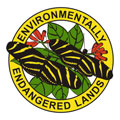Thought to be the oldest habitat in Florida, scrub habitat formed 10,000 to 100,000 years ago when sea levels were higher. As the seas rose and retreated, sandy island ridges formed from coastal dunes, creating patches of isolated land. Over thousands of years, plants and animals adapted to the dry sandy ridges and evolved in isolation.
Because the plants and animals adapted to the unique conditions of these ridges, over half the species found in scrub are endemic to this habitat, meaning they are found no where else in the world. Most scrub is found in Central Florida, although the habitat does extend south into northern Miami-Dade County.
Scrub is a critically endangered habitat, threatened by citrus farms, cattle grazing, urban development and invasion of exotic species.
Wildlife
A scrub landscape has open sandy areas scattered with tall pines, short oak and palmetto trees, and small herbaceous plants. Like the habitat, many plants and animals found in scrub are threatened or endangered.
Endangered gopher tortoises burrow dens up to 30 feet long in the open white sand, emerging to eat saw palmetto berries and the endangered paw paw’s yellow fruit. Burrowing owls and other animals also use the tortoise holes for shelter. Small threatened scrub lizards sun on rosemary bushes, waiting for insects and spiders.
The blue gray Florida scrub jay, a threatened species found only in Florida, flutters from scrub palmetto to cabbage palm looking for spiders, young frogs and snakes to eat.
Scrub in Miami-Dade County
In Miami-Dade County, scrub is found at the southern end of its range, in the form of scrubby flatwoods. Two transitional areas of scrubby flatwoods still exist in northern Miami-Dade County: "County Line Scrub" and the "Dolphin Center Addition."
Both sites have been acquired for conservation by Miami-Dade County's Environmentally Endangered Lands (EEL) Program. These two isolated sites represent the last remaining remnants in Miami-Dade County of this old and formerly extensive ecosystem.
For more information on Scrub Ecosystems, visit the Archbold Biological Station.


